The heavyweight b2b prospecting championship #3: advertising and linkedin
The heavyweight B2B prospecting championship #3: Advertising and LinkedIn

So far in our battle for the heavyweight B2B prospecting champion of the world we’ve assessed the fighting form of four ways to prospect.
And there were definitely some strong contenders in there.
But, stepping up to the scales for weigh-in right now, are two more wannabes.
Let’s see if advertising or LinkedIn look like they pack a prospecting punch.
Advertising
Without wishing to pull a knock-out blow before the bell for round 1 has even been rung, here’s some recent research from HubSpot.
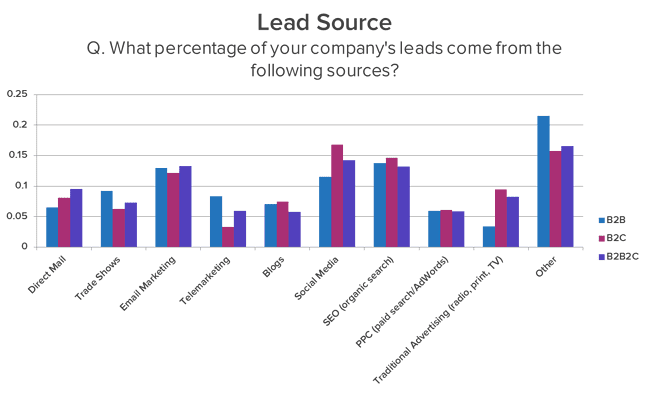
The light blue columns are B2B, our main concern here.
Some quick observations:
- B2C companies get three times more leads than B2B companies through traditional advertising (9% versus 3%)
- The best three lead sources for B2B companies are SEO (14%), email marketing (13%), and social media (12%)
- The worst three lead sources for B2B companies are traditional advertising (3%), PPC (6%), and direct mail (6%)
Interestingly, in the same survey HubSpot discovered that B2B companies were allocating 8% of their budget to PPC, but only getting 6% of their leads from that source.
(And exhibitions too had a disproportionate share of its budget (12%) for generating leads (9%).)
In many ways the rug has been pulled from under advertising’s feet as it loses face and effectiveness in the days of social selling and the informed buyer.
To summarise:
The biggest difference between B2B sales now and then is that traditional sales techniques focus on short-term sales results, whereas today’s strategies are all about building longer-term relationships.
Let’s call today’s technique ‘social selling’.
Here’s how it looks when placed in the ring with traditional sales activities:
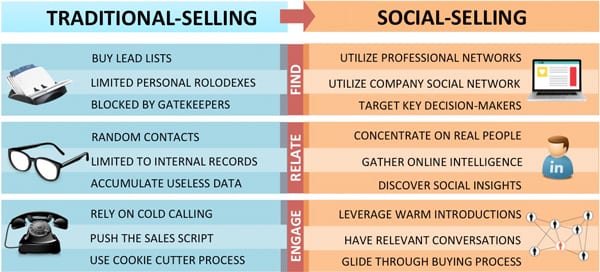
Today, 67% of the buyer’s journey takes place online: decision-makers will refer to at least 5 pieces of content before engaging with a sales rep. 84% of C-level or vice-president level executives use social media to make purchasing decisions.
They find information in the early to mid-stages of the buying process. They want to explore – and advertising wants to persuade.
This sea-change has caused a long decline in the use and effectiveness of advertising for prospecting.
Here’s the results from a B2B lead generation survey conducted in 2018 by Chief Marketer:
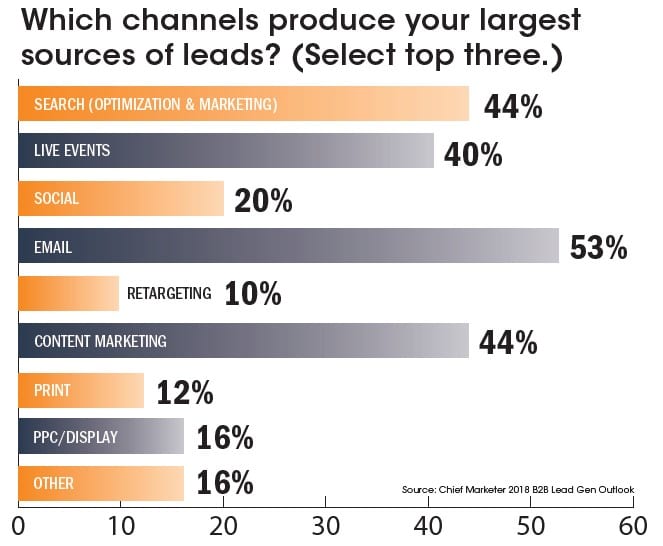
Lurking at the bottom lies print advertising, with online display ads and PPC only marginally performing better.
Poor old advertising doesn’t perform too well on the financial front either.
Here’s the average cost per lead by channel:
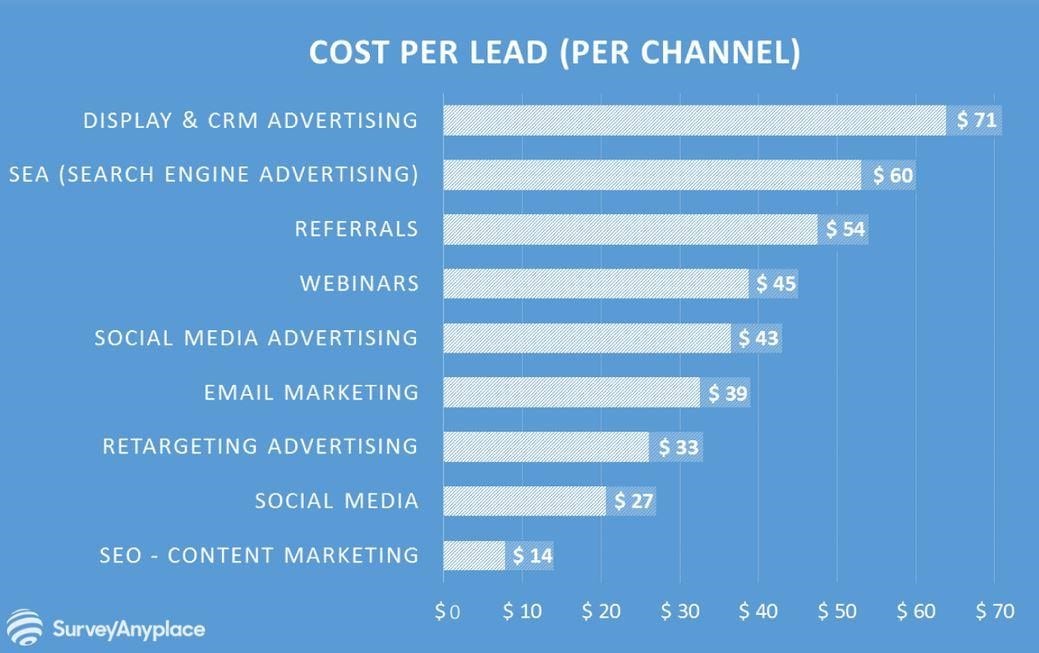
While there are wide variances between the average cost by sector, these aggregated costs give a fair indication of the cost per channel for all.
And right there at the bottom – performing well only in terms of burning through the budget – are online display marketing ($71) and PPC ($60).
Interestingly, both remarketing and social media advertising put in a more respectable showing with ($33 and $43 respectively).
It’s worth reporting here the joy several marketers report using Facebook’s Lead Gen ads – which effectively shorten the conversion process by doing away with the need for a landing page.
And we’ll check out LinkedIn next.
Another recent survey looked at ROI and produced very similar rankings:
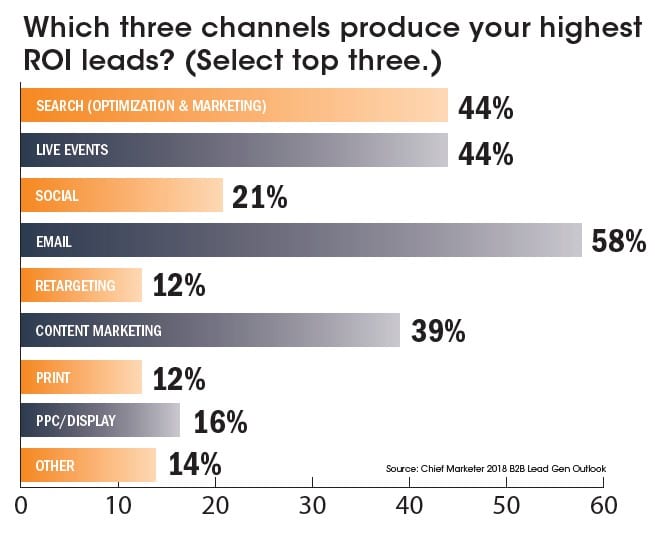
Once again print sinks to the bottom and is joined by both by PPC/display ads (and this time retargeting too).
While some B2B marketers are swearing by Facebook, and some back LinkedIn as an effective platform for using online advertising to generate leads, the simple fact is that you need more than just one or two strong punches to be the champ!
We expect a TKO for advertising in the very early rounds.
Form guide for advertising
Where B2B ads are concerned advertising has very much had its day.
In terms of time taken it’s a quick hit – but in terms of returns and cost its (more than) a bit shit.
If you avoid edgy creatives the risk of turning people off is low (but, particularly with retargeting, the risk of pissing them off is high).
Scalability is achievable – but as you scale targeting diminishes.
Take your seats.
I’m about to reel off some stats that will floor you if you are standing.
And they are going to come thick and fast!
Let’s do this.
Social media
- 90% of top performing sales people use social media as part of their sales strategy
- Social media has a 50% higher lead-to-close frequency than direct selling
- It supports the buying decision of 75% of businesses
- By spending as little as six hours per week, 66% of marketers see lead generation benefits with social media
- In fact, studies show that sales reps with high social network activity achieve 45% more sales opportunities, and are 51% more likely to hit their sales quotas
The undisputed B2B social platform
- LinkedIn is the number one channel used by 94% of B2B marketers to distribute content
- 50% of B2B web traffic originating from social media comes from LinkedIn
- LinkedIn generates 80% of B2B leads from social networks
- More than one in three B2B marketers confirmed that LinkedIn is generating revenue for their business – that’s three times more than Twitter, four times more than Facebook and 19 times more than Instagram.
- LinkedIn generates more leads and better qualified leads: it has the highest visitor-to-lead conversion rate at 2.74%, almost three times higher than Twitter (0.69%) and Facebook (0.77%)
- 90% of B2B marketers using LinkedIn lead gen forms reduced their cost per lead.
- 65% of companies said their LinkedIn marketing strategy was successful
More than just liked by salespeople
- Buyers do not object to being contacted via LinkedIn – 76% are happy to engage, 62% are happy to be contacted by a sales person and 92% welcome engagement from thought leaders
- InMail receives typical response rates as high as 25%
- 91% of executives see LinkedIn as their first choice for professionally relevant content
Whew! That was a barrage of bullet points.
If you take just one thing away from them, let it be this:
LinkedIn is a great prospecting tool.
For more on LinkedIn’s advertising options check out our guide on how to find your prospects online.
In fact, I’m thinking maybe we should put together a complete guide to LinkedIn for B2B prospectors.
Leave it with me and circle back to get the gen on the LinkedIn generation.
At the risk of repeating myself, LinkedIn’s strengths lay exactly where advertising’s weaknesses are.
We’ve covered how the buying situation has changed above.
- A recent survey by InsideView found that more than 90% of decision makers said they “never” respond to cold calls!
- And we’ve already seen they aren’t ‘immune’ to adverts
- Yet, they are happy to engage with content and with LinkedIn members
As one door closes…
Form guide for LinkedIn
LinkedIn offers the chance to start and join conversations, at barely any or a very small cost.
Its targeting options are fantastic and its conversion rate impressive.
Yet, it can take a lot of time – the suggested 6 hours a week represents almost a day out of the week. It also relies very much on having great content to post about – which is a hidden time and cost implication.
Although it passes on many more leads than other social networks, these are hardly going to be in enormous numbers if you are manually researching, finding and nurturing prospects.
And there’s no real way to scale this, despite the ever-growing network. There are only so many hours in a day.
As it is a platform that is widely liked there is minimal risk of annoying potential prospects – quite the opposite: many welcome contact.
I’d place a bet on it – the odds look good.
Trying to decide whether you should go for a sales prospecting tool or an integrated service? Check out our guide on how Sopro’s teams join the dots between automation and collaboration, providing full-service prospecting solutions managed by experts from day one.





